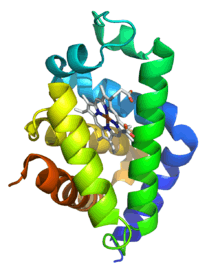Neuroglobin
| Neuroglobin | |
|---|---|
 | |
| Identifiers | |
| Symbol | NGB |
| Entrez | 58157 |
| HUGO | 6553 |
| OMIM | 605304 |
| UniProt | Q9NPG2 |
| Other data | |
| Locus | Chr. 14 q24 |
Neuroglobin is a member of the vertebrate globin family involved in cellular oxygen homeostasis. It is an intracellular hemoprotein expressed in the central and peripheral nervous system, cerebrospinal fluid, retina and endocrine tissues. Neuroglobin is a monomer that reversibly binds oxygen with an affinity higher than that of hemoglobin. It also increases oxygen availability to brain tissue and provides protection under hypoxic or ischemic conditions, potentially limiting brain damage. Neuroglobin were in the past found only in vertebrate neurons, but recently in 2013, were found in the neurons of unrelated protostomes, like photosynthesis acoel and jelly fish. In addition to neurons, neuroglobin is present in astrocytes in certain pathologies of the rodent brain[1][2] and in the physiological seal brain.[3] This is thought to be due to convergent evolution.[4] It is of ancient evolutionary origin, and is homologous to nerve globins of invertebrates. Recent research on Neuroglobin presence confirmed that Human neuroglobin protein in cerebrospinal fluid (CSF).[5]
Neuroglobin was first identified by Thorsten Burmester et al. in 2000.[6] Italian researchers suggest that neuroglobin is more likely to usher in nitric oxide to protect neuron survival and recovery in areas where oxygen supply is reduced.[7]
The 3D structure of human neuroglobin was determined in 2003.[8] The next year, murine neuroglobin was determined at a higher resolution.[9]
See also
References
- ↑ DellaValle B, Hempel C, Kurtzhals JA, Penkowa M (August 2010). "In vivo expression of neuroglobin in reactive astrocytes during neuropathology in murine models of traumatic brain injury, cerebral malaria, and autoimmune encephalitis". Glia. 58 (10): 1220–7. doi:10.1002/glia.21002. PMID 20544857.
- ↑ De Marinis E, Acaz-Fonseca E, Arevalo MA, et al. (March 2013). "17β-Oestradiol anti-inflammatory effects in primary astrocytes require oestrogen receptor β-mediated neuroglobin up-regulation". Journal of Neuroendocrinology. 25 (3): 260–70. doi:10.1111/jne.12007. PMID 23190172.
- ↑ Mitz SA, Reuss S, Folkow LP, et al. (October 2009). "When the brain goes diving: glial oxidative metabolism may confer hypoxia tolerance to the seal brain". Neuroscience. 163 (2): 552–60. doi:10.1016/j.neuroscience.2009.06.058. PMID 19576963.
- ↑ science.gov, Neuroglobins, Pivotal Proteins Associated with Emerging Neural Systems and Precursors of Metazoan Globin Diversity by Lechauve, Christophe; Jager, Muriel; Laguerre, Laurent; Kiger, Laurent; Correc, Gaelle; Leroux, Cedric; Vinogradov, Serge; Czjzek, Mirjam; Marden, Michael C.; Bail
- ↑ Casado B, Pannell LK, Whalen G, Clauw DJ, Baraniuk JN (February 2005). "Human neuroglobin protein in cerebrospinal fluid". Proteome Science. 3 (1): 2. doi:10.1186/1477-5956-3-2. PMC 554085
 . PMID 15730566.
. PMID 15730566. - ↑ Burmester T, Weich B, Reinhardt S, Hankeln T (September 2000). "A vertebrate globin expressed in the brain". Nature. 407 (6803): 520–3. doi:10.1038/35035093. PMID 11029004.
- ↑ Brunori M, Vallone B (November 2006). "A globin for the brain". FASEB Journal. 20 (13): 2192–7. doi:10.1096/fj.06-6643rev. PMID 17077295. Lay summary – Phys.org (Oct 31, 2006).
- ↑ Alessandra Pesce; Sylvia Dewilde; Marco Nardini; Luc Moens; Paolo Ascenzi; Thomas Hankeln; Thorsten Burmester & Martino Bolognes (2003). "Human Brain Neuroglobin Structure Reveals a Distinct Mode of Controlling Oxygen Affinity". Structure. 11 (9): 1087–1095. doi:10.1016/S0969-2126(03)00166-7. PMID 12962627.
- ↑ Beatrice Vallone; Karin Nienhaus; Maurizio Brunori; G. Ulrich Nienhaus (2004). "The structure of murine neuroglobin: Novel pathways for ligand migration and binding". Proteins: Structure, Function, and Bioinformatics. 56 (1): 85–92. doi:10.1002/prot.20113. PMID 15162488.
External links
- neuroglobin at the US National Library of Medicine Medical Subject Headings (MeSH)